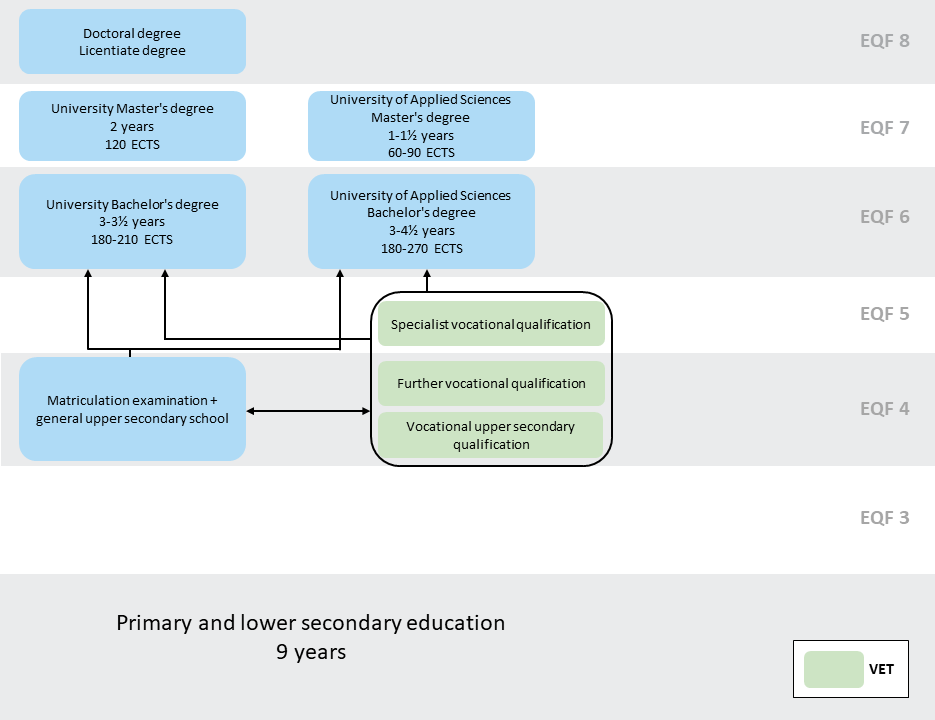1. Diagramme of the Finnish VET system
NB: The diagramme does not show all qualifications and all connections between programmes.

2. Description of the Finnish VET system
Vocational education model at EQF 4 – 5
There are three types of qualification in vocational education and training: vocational upper secondary qualification (ammatillinen perustutkinto / yrkesinriktad grundexamen), further vocational qualification (ammattitutkinto / yrkesexamen) and specialist vocational qualification (erikoisammattitutkinto /specialyrkesexamen). Vocational upper secondary qualifications and further vocational qualifications are on EQF level 4, and the specialist vocational qualifications are on EQF level 5.
All of the VET qualifications mentioned here are composed of units of learning outcomes. Vocational qualifications consist of vocational units and common units. Further and specialist qualifications comprise only vocational units and the necessity for common units is assessed when preparing the student’s personal competence development plan.
Vocational units are either compulsory or optional. Students can complete entire qualifications, parts of them or smaller units, or combine parts of different qualifications based on their needs. Competence requirements are the same in all learning environments, also in workplaces. Qualifications are the same for young people and adults.
3. Governance and stakeholders
The Finnish system is based on trust and shared responsibility. The network of vocational education and training providers plays a key role in implementing VET and ensuring the quality of training and qualifications.
Parliament decides on the legislation and the annual budget allocations to VET. The Government decides on the development of VET in the Government programme.
The Ministry of Education and Culture is responsible for the strategic and normative steering of VET and leads national development. The Ministry of Education and Culture prepares legislation related to VET and steers, regulates, finances and monitors the industry. The Ministry also makes decisions on the structure of vocational qualifications. Vocational qualifications and their scope are determined by the Ministry.
The National Agency for Education designs and makes decisions on the national qualification requirements, which describe the vocational skills requirements of qualifications and units and the methods and criteria to assess learning outcomes.
The Ministry of Education and Culture grants authorisations to provide vocational education and training. The authorisation determines the educational task of the education provider and ensures that the provider meets the conditions for providing high-quality qualifications and education. The authorisation covers VET provided to both young people and adults. The authorisation entitles the organisation to provide education required for completing vocational qualifications, to organise competence demonstrations and to issue qualifications.
The education providers independently decide on the allocation of the education they offer, and how and in which educational institutions and learning environments they provide the education. Education providers also decide how they are profiled based on different fields or client groups and what kind of staff they employ.
4. Types of vocational educational institutions
VET is organised mainly in institutions or as apprenticeship training.
A list of education providers that have been granted authorisation to provide vocational education and training is available in Finnish and Swedish at the Oiva website (steering and regulatory services of the Ministry of Education and Culture) https://oiva.okm.fi/fi/jarjestamis-ja-yllapitamisluvat/ammatillinen-koulutus
5. Quality assurance
In VET, quality assurance consists of the quality management systems of education providers, national guidance and regulation, and external evaluation. The legislation regulating VET requires education providers to evaluate the qualifications, education and other activities they provide as well as their quality and effectiveness. Education providers must also regularly participate in external evaluation of their activities and quality management systems. Tripartite working life committees are involved in quality assurance of competence demonstrations and the assessment of skills.
6. National qualifications framework for Lifelong Learning (NQF-LLL)
The Finnish National Framework for Qualifications (FiNQF) describes the qualifications, syllabuses and other extensive competence modules that belong to the Finnish national education system. The FiNQF includes, among other things, general education, vocational education and higher education.
The qualifications, syllabuses and other extensive competence modules are classified into eight levels based on the required competences. The competences acquired at each level are defined in the Government decree, and the level descriptors are in line with the level requirements of the European qualifications framework.
More information about qualifications frameworks is on the website of the Finnish National Agency for Education: https://www.oph.fi/en/education-and-qualifications/qualifications-frameworks
7. Useful links
Studyinfo (information for students): https://opintopolku.fi/konfo/en/sivu/vocational-education-and-training-vet
Qualification requirements for vocational qualifications (under each qualification also certificate supplement available in Finnish, Swedish and English): https://eperusteet.opintopolku.fi/#/en/selaus/ammatillinen
Education system in Finland, Ministry of Education and Culture: https://okm.fi/documents/1410845/15514014/Education+system+in+Finland/7c5a920b-47a5-c3ce-cbca-818ff3a5f848/Education+system+in+Finland.pdf?t=1663149888663
Norden.org: https://www.norden.org/en/info-norden/upper-secondary-school-and-vocational-education-and-training-finland
8. VET system in Åland
The autonomous Åland has its own education legislation.
Ålands yrkesgymnasium (Åland’s Upper Secondary Vocational School) offers vocational upper secondary education in several different vocational programmes. Completed studies lead to an upper-secondary qualification with vocational direction (gymnasieexamen med yrkesinriktning). It includes an upper-secondary school certificate (gymnasiebetyg) and a certificate of skills demonstration (yrkesprovsbetyg).
The vocational programmes prepare graduates to independently practise a profession or to continue on to higher education studies. The gymnasieexamen med yrkesinriktning provides general eligibility for further studies within universities of applied sciences and universities. Vocational qualifications can also be completed by means of an apprenticeship. Apprenticeships are based on a fixed-term employment relationship between an employer and a student, during which the student receives on-the-job training.
More information about the education system and the qualifications framework in Åland:
https://www.regeringen.ax/utbildning-larande
https://www.utbildning.ax/nyheter/alandska-referensramen-kvalifikationer-axqf
